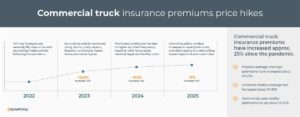
5 Ways to Ease The Burden of Truck Fleet Insurance Premiums
Content
Insurance is one of the most significant recurring expenses, second only to fuel and payroll for many fleets. Over the last several years, premiums have continued to climb, driven by rising accident claims, repair costs, and industry-wide risk assessments. While insurance is an essential requirement to run a safe and compliant fleet, the cost burden is a significant strain on operating budgets for many fleets. Fortunately, there are practical ways to ease the burden without compromising coverage or cash flow.
This article explores five strategies to reduce the impact of rising fleet insurance premiums, along with flexible financing options to help you manage large upfront costs without disrupting operations.
Premiums are up ~25% since the pandemic
Since the pandemic, commercial truck insurance premiums have jumped sharply. Increased costs are primarily due to a combination of inflation (including parts, labour, and vehicle costs), as well as the increased frequency and severity of claims. Additional influencing conditions include rising legal/litigation costs, supply chain strains delaying repairs, and stricter underwriting due to losses. In total, commercial truck insurance premiums have increased approximately 25% since the pandemic.

As rising premiums can quickly strain cash flow and directly impact profitability, trucking fleets must plan ahead and take strategic action to mitigate the high cost of insurance premiums.
5 strategic actions to mitigate high premium costs
Forward-thinking trucking fleets are laser-focused on cost reduction and operational efficiencies to remain resilient and competitive as trucking costs set new records in 2025. With insurance premiums representing the third-highest operational expense for most trucking companies, fleet owners and executives must implement strategic actions to mitigate the high cost of insurance.
The following are five strategic actions to help mitigate high premium costs:
- Improve driver training and safety programs
Why it matters:
Insurance providers price risk based on your fleet’s loss history and safety record. A fleet with frequent claims will pay higher premiums, while fleets that demonstrate proactive risk management, such as driver safety training programs, are rewarded with discounts and more favorable renewal terms.
Practical steps:
- Implement ongoing driver training programs focusing on defensive driving, fatigue management, and accident prevention.
- Use telematics technology to monitor driving behavior—such as harsh braking, speeding, or idle time—and provide targeted coaching.
- Incentivize safe driving with recognition programs and financial bonuses for accident-free periods.
Impact:
By reducing accidents and claims, you not only save on repair costs but also improve your risk profile, giving underwriters more confidence to offer better rates.
- Optimize fleet management through technology
Why it matters:
Insurance companies look favorably on fleets that use modern risk-mitigation tools. Proving that your fleet invests in monitoring and prevention demonstrates that you take safety seriously.
Practical steps:
- Use GPS, dashcams, and telematics to track driver behavior. This helps fleets to reduce risky driving habits and provide data that insurers reward with lower premiums.
- Adapt predictive maintenance systems with advanced diagnostics and IoT sensors to identify mechanical issues early, thereby preventing breakdowns and accidents that could otherwise lead to increased insurance costs.
- Initiate data-driven safety programs leveraging analytics from technology platforms to implement targeted safety training, improve compliance scores, and demonstrate lower risk profiles to insurers.
Impact:
Fleets that can show insurers a track record of data-driven decision-making are often able to negotiate lower premiums. In addition, the operational efficiencies reduce costs beyond just insurance.
- Review and right-size your coverage regularly
Why it matters:
Fleet insurance policies can become bloated over time. Businesses may pay for coverage they no longer need or fail to adjust deductibles to balance risk and cost.
Practical steps:
- Conduct a comprehensive annual policy review with a broker who understands your industry.
- Adjust deductibles. Higher deductibles may lower your premium if you have the cash reserves or sufficient cash flow to absorb smaller claims.
- Ensure vehicles that are no longer in service or that have been sold are removed from your coverage list immediately.
- Compare quotes across insurers each renewal cycle; loyalty doesn’t always mean better pricing.
Impact:
Right-sizing your coverage ensures you are not paying for unnecessary protection while maintaining compliance and peace of mind.
- Strengthen your risk profile with preventive policies
Why it matters:
Insurance is fundamentally about risk. The stronger your internal policies, the more attractive your fleet becomes to insurers.
Practical steps:
- Establish clear hiring standards. Background checks, clean driving records, and drug testing should be non-negotiable.
- Enforce strict maintenance schedules and keep thorough records to demonstrate compliance and vehicle reliability.
- Develop accident response protocols that show insurers you can minimize losses when incidents occur.
Impact:
A structured, documented approach to fleet safety reassures insurers that you’re not just reacting to problems but actively preventing them. This lowers perceived risk and can directly reduce your premium burden.
- Use flexible financing to manage upfront insurance costs
Why it matters:
One of the most challenging aspects of fleet insurance is the large upfront payment required when policies renew. This sudden cash demand can disrupt your working capital and restrict your ability to pay for fuel, maintenance, or payroll.
Implement flexible financing strategies to spread costs and ease the burden:
- Monthly installments: Spread the cost of your annual insurance premium into predictable monthly installments. This approach avoids paying a single large cash outlay, spreads the burden evenly throughout the year, and allows this expense to better align with cash flow cycles.
- Leverage industry-specific financing options: The best transportation financing lenders offer tailored cash flow solutions with minimal lending covenants to maximize flexibility. These solutions streamline processes, ensuring reliable and cost-effective access to working capital.
- Freight factoring: Convert freight bills into immediate cash within hours to accelerate liquidity. This mainstream funding option fast-tracks access to working capital, allowing fleets to meet operational expenses without waiting 30, 60, or 90 days for customers to settle invoice payments.
- Asset-based lending (ABL): Use your fleet’s receivables, working equipment, or real estate assets as collateral to secure a revolving line of credit. This flexible funding option allows fleets to withdraw funds as needed, pay fees only on the funds used, and replenish the credit line as new freight bills are generated or tangible assets grow.
- Fuel and factoring bundles: Leading transportation financing providers offer tailored fleet solutions that combine cost-saving fuel cards and freight factoring into one beneficial program.
Impact:
By aligning insurance costs with ongoing cash inflows and improving liquidity, fleets can reduce financial strain, stay current on obligations, and preserve the flexibility to reinvest in growth without depleting essential resources.
Conclusion
Fleet insurance is essential, but it shouldn’t derail your company’s financial stability. Despite rising fleet insurance premiums feeling like an excessive cost burden, your fleet doesn’t have to absorb this business expense without a strategy. Fleets that take a proactive stance, by improving safety, leveraging technology, right-sizing coverage, and strengthening internal risk policies, are better positioned to control premiums over time.
And when large upfront insurance costs threaten to squeeze cash flow, flexible financing options provide a lifeline. With specialized financing solutions tailored specifically for the transportation industry, fleets can meet financial obligations in a timely fashion and keep operations moving forward without disruption.
By combining operational strategies with innovative financial tools, you can protect your business, control rising costs, and ensure your fleet remains competitive.
Contact us today to learn how flexible financing solutions can help you ease the burden of high fleet insurance premiums and keep your business on the road to growth.
Key Takeaways
- While fleet insurance is a non-negotiable part of running a safe and compliant operation, there are practical ways to ease the cost burden without compromising coverage or cash flow.
- This article explores five strategies to reduce the impact of rising fleet insurance premiums, along with flexible financing options to help you manage large upfront insurance costs without disrupting operations.
- By combining operational strategies with smart financial tools, you can protect your business, control rising costs, and ensure your fleet remains competitive.
ABOUT eCapital
At eCapital, we accelerate business growth by delivering fast, flexible access to capital through cutting-edge technology and deep industry insight.
Across North America and the U.K., we’ve redefined how small and medium-sized businesses access funding—eliminating friction, speeding approvals, and empowering clients with access to the capital they need to move forward. With the capacity to fund facilities from $5 million to $250 million, we support a wide range of business needs at every stage.
With a powerful blend of innovation, scalability, and personalized service, we’re not just a funding provider, we’re a strategic partner built for what’s next.


